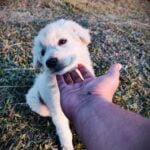Walking a dog should be an enjoyable activity, but many owners struggle with their dogs pulling on the leash. In this article, we will explore how to train a dog to not pull while walking. Proper leash training is essential for both the safety of your dog and those around you. It establishes control and ensures that walks are comfortable and stress-free for both you and your furry companion.
Pulling on the leash is a common behavior among dogs, but understanding the psychology behind it can help us address the issue effectively. Dogs have natural instincts to explore their surroundings and follow scents, which can lead to pulling. However, with the right guidance and techniques, you can teach your dog to walk calmly on a loose leash.
Choosing the right equipment is another crucial aspect of leash training. Collars, harnesses, and leashes vary in design and function, so it’s important to select the one that suits your dog’s size, breed, and individual needs. By providing proper equipment, you can ensure your dog’s comfort during walks and lay a solid foundation for successful training.
Understanding the Psychology Behind Pulling Behavior
When it comes to training your dog not to pull while walking, it is important to have a deep understanding of the psychology behind this behavior. Dogs are naturally curious and have a strong prey drive, which often leads them to want to explore their surroundings by pulling on the leash. By understanding why dogs pull, you can take a more effective approach in teaching them how to walk on a loose leash.
One reason dogs pull while walking is because they are excited or overstimulated by their environment. They may see something interesting or smell an enticing scent, causing them to become overly eager and forget about proper leash manners. It is also possible that they have had positive experiences with pulling in the past, such as being rewarded for reaching certain destinations quickly. In these cases, pulling becomes a learned behavior that they continue to engage in.
Another factor that contributes to pulling behavior is the natural instinct of dogs to lead. Dogs are pack animals by nature, and in the wild, being at the front of the pack signifies leadership. When your dog pulls on the leash, they might be trying to take charge and explore their surroundings as if leading the way for you.
To address these psychological factors behind pulling behavior, it is crucial to establish yourself as the leader and teach your dog that pulling is not acceptable. This can be achieved through consistent training methods based on positive reinforcement. By setting clear boundaries and rewarding your dog for walking calmly by your side, you will gradually change their mindset and encourage them to walk on a loose leash.
To reinforce this new behavior effectively, include regular training sessions as part of their routine walks. Use treats or verbal praise as rewards when your dog maintains a loose leash position and avoids pulling. Over time, they will start associating good behavior with positive outcomes and be more motivated to walk calmly by your side.
Understanding why dogs pull while walking can greatly assist you in successfully teaching them proper leash manners. By recognizing the psychological factors at play and implementing a consistent positive reinforcement training routine, you can effectively curb pulling behavior and ensure enjoyable walks with your furry friend.
Choosing the Right Equipment
One of the first steps in training your dog to not pull while walking is selecting the right equipment. The type of equipment you choose can greatly impact your dog’s behavior on walks, so it’s important to make an informed decision. Here are some options to consider:
- Collars: Traditional collars are commonly used for walking dogs, but they may not be the best choice for dogs that tend to pull. Pressure applied from a collar can cause discomfort and even injury to your dog’s neck. However, if your dog is already well-behaved on a leash or has a short snout, a martingale or slip collar may provide some control without causing harm.
- Harnesses: Harnesses distribute leash pressure across your dog’s body, reducing strain on their neck and throat. A front-clip harness can discourage pulling by redirecting your dog’s forward motion whenever they start to pull ahead. This type of harness can be particularly helpful for larger or stronger dogs. Alternatively, a back-clip harness provides more freedom of movement but may be less effective for reducing pulling.
- Leashes: The leash you choose should be sturdy and comfortable to hold. Retractable leashes are not recommended for training purposes as they encourage pulling and lack control. Instead, opt for a fixed-length leash that gives you better control over your dog’s movements.
Remember that every dog is different, so it may take some trial and error to find the equipment that works best for both you and your furry friend.
Investing time in researching and selecting the right equipment will pay off in making walks more enjoyable and effective during training sessions.
When choosing the right equipment for your pup, it’s always helpful to consult with professional trainers or experienced dog owners who can offer guidance based on their own experiences with similar breeds or situations.
Establishing a Positive Reinforcement Training Routine
Creating a Training Plan
To effectively train your dog to not pull while walking, it is important to establish a positive reinforcement training routine. Begin by creating a training plan that outlines the specific behaviors you want to teach your dog and the steps you will take to reinforce those behaviors. Having a clear and structured plan will help both you and your dog stay focused and motivated throughout the training process.
Setting Realistic Goals
When setting goals for your dog’s leash training, it is important to be realistic and set achievable milestones. Keep in mind that every dog learns at their own pace, so patience is key. Break down the training into smaller tasks, gradually increasing the difficulty level as your dog masters each step. This will prevent frustration for both of you and build a solid foundation for future success.
Consistency in Training
Consistency is crucial when establishing a positive reinforcement training routine. Dogs thrive on routines and repetition, so it’s important to consistently enforce the same rules and cues during each training session. Use clear commands, hand gestures or clicker training to communicate with your dog effectively. Be sure to reward desired behaviors promptly and consistently with treats, praise, or playtime.
Timing is Everything
Timing plays a critical role in positive reinforcement training. Dogs associate rewards with their immediate actions or behavior. Therefore, it is essential to deliver rewards immediately after your dog has performed the desired behavior correctly. Delayed rewards may confuse your furry friend or cause them to associate the reward with something else entirely.
By establishing a positive reinforcement training routine, you can effectively teach your dog not to pull while walking. Creating a structured plan, setting realistic goals, maintaining consistency in training sessions, and ensuring proper timing of rewards are all key factors in achieving success in leash training. Stay patient and committed, and soon you’ll be enjoying stress-free walks with your well-behaved canine companion.
Step-by-Step Guide
Walking your dog on a loose leash is essential for a pleasant and safe walking experience. Teaching your dog this skill not only allows for more enjoyable walks but also establishes you as the leader and helps prevent injuries caused by pulling. Here is a step-by-step guide to help you train your dog to walk on a loose leash.
- Start in a Low-Distraction Environment: Begin training in a quiet, familiar place without too many distractions. This will help your dog focus and learn more effectively. Gradually increase the difficulty level as your dog improves.
- Use Positive Reinforcement: Positive reinforcement is an effective training technique that involves rewarding desired behavior with treats, praise, or playtime. When your dog walks beside you without pulling, immediately praise and reward them with a treat or enthusiastic praise.
- Establish Walking Positions: Teach your dog different positions and cues for walking on a loose leash. The “heel” position involves walking right beside you, while the “close” position allows for slightly more freedom but still prevents pulling. Practice these positions consistently during training sessions.
| Training Step | Description |
|---|---|
| Lure Method | Hold a treat close to your leg and let your dog follow it while walking. Reward them when they stay close without pulling. |
| Stop-and-Go Method | When your dog pulls, stop immediately and wait until they loosen the leash tension before continuing to walk. |
| Changing Directions | Suddenly change direction whenever your dog starts pulling to encourage them to pay attention and follow your lead. |
Remember, consistency is key when training a dog to walk on a loose leash. Practice regularly, gradually increase the difficulty of the training environment, and be patient with your furry friend. With time and dedication, your dog will learn to walk calmly by your side, making walks more enjoyable for both of you.
Consistency and Patience
Training a dog to not pull while walking can be a challenging process that requires consistency and patience. It is important to understand that setbacks and challenges are part of the training journey, but with the right mindset and approach, they can be overcome.
One common challenge during leash training is when a dog becomes easily distracted by their surroundings. They may try to chase after squirrels, other dogs, or even cars. This can make it difficult for them to maintain focus and walk calmly on a loose leash. To overcome this challenge, it is important to gradually introduce distractions into their training routine.
Start with low-level distractions such as mild sounds or enticing smells in a controlled environment. As your dog becomes more comfortable and focused, gradually increase the level of distractions they are exposed to. Reward them for maintaining their focus and calmly walking beside you despite the distractions.
Another challenge that owners may face is when their dog reverts back to pulling behavior after showing progress during training sessions. This setback can be frustrating, but it is important not to get discouraged. Instead, reassess your training routine and make any necessary adjustments.
It could be helpful to go back a few steps in the training process and reinforce basic commands and expectations before moving forward again. Consistency in your training routine will help your dog understand what is expected of them and reduce the likelihood of setbacks.
Patience is key when dealing with challenges and setbacks during leash training. Every dog learns at their own pace, so it is important not to rush the process or become frustrated if progress seems slow. Celebrate even small victories along the way and remember that consistency in your approach will eventually pay off.
| Challenge | Solution |
|---|---|
| Dog easily distracted during walks | Gradually introduce distractions during training sessions, starting with low-level distractions and gradually increasing the level of difficulty. |
| Dog reverts back to pulling behavior | Reassess training routine, make necessary adjustments, and reinforce basic commands and expectations before moving forward. |
| Progress seems slow | Be patient and celebrate small victories along the way. Consistency in training routine is key. |
Troubleshooting
During the process of training a dog to not pull while walking, it is common to encounter various issues and challenges. Understanding these common issues and having effective solutions in place can greatly improve the training experience for both you and your dog.
One common issue that many dog owners face is their dog becoming easily distracted during walks. Dogs are naturally curious creatures, and it can be difficult for them to resist the urge to explore new smells or sights. To address this issue, it is important to gradually introduce distractions into the training routine.
Start with low-level distractions, such as practicing in a quiet park with minimal foot traffic, and gradually increase the level of distraction as your dog becomes more comfortable and focused. Using treats or toys as rewards can also help redirect your dog’s attention back to you when they become distracted.
Another common issue is pulling on the leash due to excitement or frustration. Many dogs have a high energy level and may become overly excited during walks, leading them to pull on the leash. To address this issue, it is crucial to teach your dog self-control and patience.
Incorporate exercises that promote calm behavior before starting your walk, such as having your dog sit and stay until they are calm before proceeding forward. Additionally, you can use gentle techniques like turning around or stopping whenever your dog starts pulling, giving them the message that pulling will not get them closer to their desired destination.
Lastly, some dogs may exhibit fear or anxiety during walks, which can contribute to pulling behavior. This could be triggered by loud noises, unfamiliar environments, or encounters with other dogs or people. If your dog displays signs of fear or anxiety during walks, it is important to address these underlying emotions first before focusing on loose leash walking specifically. Gradual desensitization techniques paired with positive reinforcement can help alleviate your dog’s fears over time.
By addressing these common issues with patience and consistency throughout the training process, you can overcome setbacks more effectively and ensure a successful training outcome. Remember to always remain calm and positive, as your dog’s behavior can be greatly influenced by your own energy and emotions.
Incorporating Distraction and Advanced Training Techniques
Introducing Distractions Gradually
Once your dog has mastered the basic skills of walking on a loose leash, it’s time to introduce distractions into your training routine. This step is essential for ensuring that your dog remains attentive and well-behaved in various environments. However, it’s important to remember that introducing distractions too quickly can overwhelm your dog and hinder their progress.
Start by gradually exposing your dog to low-level distractions, such as other dogs at a distance or mild noises. For example, you can take your dog to a quiet park where there are minimal distractions initially. As your dog becomes more comfortable and confident in these situations, gradually increase the level of distraction.
Utilizing Positive Reinforcement with Distractions
When working with distractions, it’s crucial to continue using positive reinforcement techniques. Reward your dog for maintaining loose leash walking even in the presence of distractions. You may need to use higher-value treats or praise to keep their attention focused on you during these challenging situations.
Continue practicing the basic commands and techniques you’ve already taught your dog while incorporating distractions. For instance, ask your dog to sit or lie down while another person walks by with their dog at a distance. Gradually decrease the distance between your dog and the distraction as they become more comfortable and adept at ignoring external stimuli.
Advanced Training Techniques for Loose Leash Walking
As you and your dog progress in your loose leash walking journey, you can introduce advanced training techniques that will further reinforce their skills. One effective technique is “stop-start” training. This involves abruptly stopping when your dog begins to pull on the leash, waiting for them to return to a loose leash position before continuing forward.
Additionally, you can practice changing directions during walks as another way of engaging their focus and eliminating pulling behavior. By randomly turning left or right without any cues from your dog, you teach them to pay attention to your movements and adjust their position accordingly.
Remember to always keep the training sessions fun and positive. Advanced training techniques may require more patience and consistency, but by remaining dedicated and incorporating them into your walks, you are one step closer to having a well-behaved, leash-trained dog.
Maintaining Good Walking Etiquette
A stress-free walk is not only beneficial for your dog’s physical health, but it also contributes to their mental well-being. Maintaining good walking etiquette ensures that both you and your furry companion can enjoy a pleasant experience outdoors. Here are some tips to help you achieve a stress-free walk.
First and foremost, it is important to start the walk with a calm and relaxed mindset. Dogs are highly perceptive creatures and they can pick up on any tension or stress you may be feeling. Take a few moments before starting the walk to breathe deeply, clear your mind, and set a positive tone for the walk ahead.
Next, it is crucial to utilize proper leash handling techniques. Holding the leash tightly or constantly tugging on it can send mixed signals to your dog and may contribute to pulling behavior. Instead, hold the leash loosely and keep slack in it while maintaining a firm grip. This allows your dog to have some freedom while still maintaining control.
Additionally, practicing good leash manners involves being aware of your surroundings. It is considerate to be mindful of others sharing the sidewalk or park by keeping a reasonable distance between them and your dog. If there are other dogs or people passing by, guide your dog away from them if necessary to avoid any potential conflicts or uncomfortable interactions.
Furthermore, being prepared is key when it comes to maintaining good walking etiquette. Always bring waste bags with you and promptly clean up after your dog if they relieve themselves during the walk. This shows respect for the environment and consideration for others who may be using the same area.
Lastly, make sure you reward and reinforce positive behavior during the walk. Whenever your dog walks calmly beside you without pulling, offer verbal praise or small treats as rewards. This will encourage them to continue exhibiting good walking manners in future walks.
By following these tips for maintaining good walking etiquette, you can create a stress-free environment that promotes enjoyable walks for both you and your furry friend. Remember, consistency and patience are key, and with time and practice, your dog will become a well-behaved walking companion.
Conclusion
Training a dog to not pull while walking is a process that requires patience, consistency, and understanding. It is important to remember that every dog is unique and may require different training methods or equipment. However, through positive reinforcement and following a step-by-step guide, you can successfully teach your dog to walk on a loose leash.
Throughout the training process, it is crucial to celebrate your dog’s progress. Whether it’s taking small steps forward or overcoming setbacks, acknowledge and reward your dog for their efforts. Celebrating their progress will not only boost their confidence but also strengthen the bond between you and your furry friend.
As you continue to train your dog, it’s important to remember that walks are meant to be enjoyable experiences for both of you. Use this time as an opportunity to bond with your pet and explore the world together. Practice good walking etiquette by being aware of your surroundings and respecting other people and animals you encounter on walks.
Ultimately, with consistency, patience, and positive reinforcement, you will be able to successfully train your dog not to pull while walking. By following the step-by-step guide outlined in this article and troubleshooting common issues along the way, you can establish good walking habits with your furry companion. So take pride in the progress you’ve made and enjoy many stress-free walks together in the future.
Frequently Asked Questions
How do you walk your dog if he keeps pulling?
When faced with a dog that constantly pulls during walks, it’s important to address this behavior to ensure a more pleasant and controlled experience. One effective method is to use positive reinforcement techniques while walking your dog. Start by using treats or rewards to encourage your dog to walk beside you without pulling.
As soon as your dog starts to pull, stop walking and wait for them to calm down before continuing. Consistency is key here, so be patient and persistent with the process. Additionally, using a well-fitting harness or gentle leader can provide you with better control over your dog’s movements, discouraging pulling.
How do I train my dog to heel and not pull?
Training a dog to heel properly and refrain from pulling on the leash requires time, patience, and consistent training techniques. Begin by teaching your dog the basic command of “heel” in a distraction-free environment. Use positive reinforcement such as treats or praise when they successfully walk by your side without pulling.
Gradually introduce distractions during training sessions to help them practice heeling despite external stimuli. Remember to always reward good behavior and redirect any attempt at pulling with a “heel” command and immediate correction. It’s crucial not to use punishment-based methods but instead focus on rewarding desired behavior throughout the training process.
Do dogs naturally stop pulling on leash?
While some dogs may naturally exhibit less pulling behavior than others, most dogs do require some level of training to completely stop pulling on the leash. Dogs have an inherent tendency to explore their surroundings through their senses, including scent-based investigations or approaching interesting objects/people they encounter while walking on a leash. However, through consistent and positive reinforcement training techniques, dogs can learn alternative behaviors that discourage pulling on the leash over time.
This process usually involves reinforcing appropriate loose leash walking behaviors and redirecting any attempts at pulling with gentle corrections and verbal cues like “heel.” With perseverance, many dogs can be taught not to pull on the leash reliably.

Welcome to the blog! I am a professional dog trainer and have been working with dogs for many years. In this blog, I will be discussing various topics related to dog training, including tips, tricks, and advice. I hope you find this information helpful and informative. Thanks for reading!





